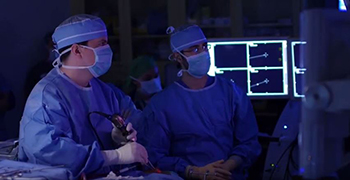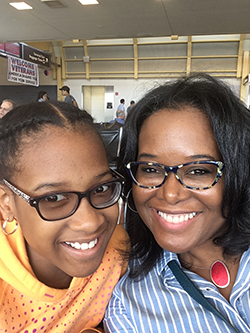A Better Brain Tumor Cure is Right Under Your Nose at MedStar Georgetown University Hospital
When D.C. resident Dawn Goodloe started having trouble reading road signs and licenses plates in the middle of last year, her brain jumped to the most logical conclusion.
“I hadn’t been to the eye doctor for a couple of years, so I just figured I needed a new prescription,” says the 47-year-old legal assistant.
However, after vision correction failed to clear things up, an MRI revealed the shocking truth: her brain was the problem all along. Those MRI images showed a meningioma – a usually benign tumor – pushing into her optic nerve.
"I had absolutely no idea that I was walking around with a brain tumor, other than the fact that my vision was really blurry,” Goodloe says. "I wasn't having headaches, I wasn't having dizziness. Nothing.”
Plans to buy a new pair of glasses suddenly jumped to a potentially life-changing brain surgery.
“I was beyond fearful because I’ve never been in the hospital for anything, other than to have my daughter. All I could think about were worst case scenarios,” Goodloe says.

Just a few days later at MedStar Georgetown University Hospital, Neurosurgeon Amjad Anaizi, MD, recommended a newly developed surgical procedure for meningioma: the expanded endoscopic endonasal approach. That means using advanced instruments to remove the entire tumor through Goodloe’s nose.
Not only is it possible but, with the right training and expertise, doctors say the operation is better for the patient’s overall recovery.
"MedStar Georgetown is one of the few places in the country that offers an endonasal treatment for this particular kind of tumor," says Anaizi. “It avoids incision of the head, avoids the pain associated with that, and avoids any manipulation of the normal brain."
According to Anaizi, meningioma is traditionally removed by craniotomy, or surgery through the top of the head. The endoscopic endonasal approach gets to the tumor from underneath by navigating the nasal cavity and sinuses. It’s a more direct route and often leaves the patient looking like they didn’t have surgery at all. At MedStar Georgetown, Anaizi tag-teams the operations with Otolaryngologist Timothy DeKlotz, MD.
“I think having two sets of eyes on a complicated problem is always helpful,” says DeKlotz. “The combination of two endoscopic trained skull-base surgeons who work together on these is very uncommon.”
 The roughly six and a half hour procedure begins with DeKlotz opening up the nose and sinuses. Then, Anaizi carefully removes the tumor from beneath the membrane on which it sits. The operation relies on longer tools that can reach the tumor from outside the head, and a high quality camera piloted by Dr. DeKlotz.
The roughly six and a half hour procedure begins with DeKlotz opening up the nose and sinuses. Then, Anaizi carefully removes the tumor from beneath the membrane on which it sits. The operation relies on longer tools that can reach the tumor from outside the head, and a high quality camera piloted by Dr. DeKlotz.
“It gives us access to tumors and the ability to manage certain diseases that were not able to be effectively treated at all.” DeKlotz says. “A lot of it comes from the experience of working together, knowing the limits, and continuing to push those limits as we learn more about what can be done safely and effectively.”
Goodloe’s tumor was not cancerous, but her eyesight continued to get worse at it grew. She had a big decision to make. Any surgery could potentially damage her optic nerve, carotid artery and other complex blood vessels. However, she was determined to get better.
"I was really scared because I was facing the threat of not being able to watch my daughter grow up, or grow old with my husband and I didn’t know what was going to happen."
In the end, she leaned on confidence in her two new specialists and elected to have the endoscopic endonasal operation.
It was the right decision.
Goodloe was placed under anesthesia throughout the procedure and later woke to a much clearer image of her recovery room. The tumor was gone. Her vision had improved drastically. The operation was a success.
 "I opened my eyes and I could see. It was amazing. I'll never forget that feeling," she says.
"I opened my eyes and I could see. It was amazing. I'll never forget that feeling," she says.
In recovery, Goodloe remained in the hospital for four days as her nose was packed with gauze. There, her nasal cavity began to heal. For a week, she only breathed out of her mouth and avoided blowing her nose. Those brief adjustments ended up paying off in the end and after only two months she returned to work.
“When I came back to work, I think everyone was expecting me to have a shaved head and a big scar on the side,” she says. “I didn’t look like I had surgery. They could not tell.”
“We get people home more quickly with the endoscopic endonasal approach,” DeKlotz says. “The healing process involves fewer complications and it happens a lot faster.”
“It’s dramatic,” says Dr. Anaizi. “There’s more recent evidence that shows clear advantages. The visual outcomes are better and the seizure rates are lower.”
For Goodloe, it meant getting back the one precious thing her tumor was slowly taking away: the clear sight of her husband and 10-year-old daughter.
“It gets better every day. I feel myself getting stronger every day. I’m just happy to be alive and here and have amazing doctors who helped me,” she says.
Categories
Media Contact
Marianne Worley
Director of Media Relations
Office: 703-558-1287Pager: 202-405-2824
Brendan McNamara
Media Relations Specialist
Office: 703-558-1593








